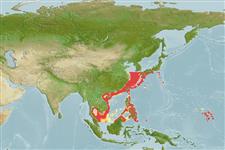Environment: milieu / climate zone / depth range / distribution range
Ekologi
marina bottenlevande; djupintervall 20 - 164 m (Ref. 9494). Tropical; 34°N - 4°N
Western Pacific: South China Sea north to China and Japan (Ref. 9774); also from the Philippines (Ref. 4537).
Size / Vikt / Age
Maturity: Lm ? range ? - ? cm
Max length : 35.0 cm SL hane/ej könsbestämd; (Ref. 9774); common length : 22.5 cm SL hane/ej könsbestämd; (Ref. 9774); rapporterad maxålder: 5 år (Ref. 72462)
Taggstrålar i ryggfenan (totalt) : 0; Mjukstrålar i ryggfenan (totalt) : 77 - 89; Taggstrålar i analfenan: 0; Mjukstrålar i analfenan: 60 - 69; Ryggkotor: 37 - 39. Body brownish, a distinct ocellus at junction of straight and curved parts of lateral line. Many dark rings scattered on body, many dark spots on median fins. A line connecting base of dorsal-fin ray and posterior nostril on eyed side passes behind posterior end of maxilla, or crosses its posterior part. Gill rakers moderately long and slender. Soft ray count of pectoral fin refers to that on ocular side (Ref 9774).
Inhabits mud and sand bottoms of shallow coasts or bays (Ref. 9774, 11230, 48637) to 164 m (Ref. 9494). Feeds on small benthic crustaceans and fishes (Ref. 9774). Also caught with small bottom trawls (Ref. 9774). Marketed mostly fresh (Ref. 9774).
Life cycle and mating behavior
Maturities | Reproduktion | Spawnings | Egg(s) | Fecundities | Larver
Distinct pairing (Ref. 205).
Masuda, H., K. Amaoka, C. Araga, T. Uyeno and T. Yoshino, 1984. The fishes of the Japanese Archipelago. (plates). Tokai University Press, Shinjuku Tokai Building. Tokyo, Japan. 437 p. (Ref. 711)
IUCN Red List Status (Ref. 130435)
Threat to humans
Harmless
Human uses
Fiskeri: kommersiell
Verktyg
Special reports
Download XML
Internet-källor
Estimates based on models
Preferred temperature (Ref.
123201): 17.8 - 27.4, mean 23.9 °C (based on 197 cells).
Phylogenetic diversity index (Ref.
82804): PD
50 = 0.5000 [Uniqueness, from 0.5 = low to 2.0 = high].
Bayesian length-weight: a=0.00646 (0.00337 - 0.01237), b=3.14 (2.98 - 3.30), in cm total length, based on LWR estimates for this species & Genus-body shape (Ref.
93245).
Trofisk nivå (Ref.
69278): 4.0 ±0.66 se; based on food items.
Generation time: 3.5 ( na - na) years. Estimated as median ln(3)/K based on 1
growth studies.
Resiliens (Ref.
120179): Hög, lägsta populationsfördubblingstid mindre än 15 månader (K=0.31).
Fishing Vulnerability (Ref.
59153): Low to moderate vulnerability (35 of 100).
